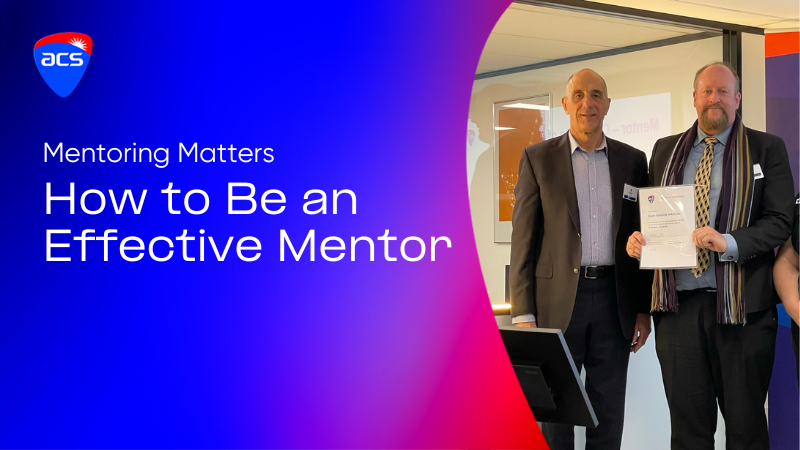
How-to Guide for Mentors to support mentees
This article is based on insights from Peter Lambert’s mentoring experiences.
Highlights
- Understanding the need of mentees
- Guiding mentees on career progresion
- Understanding common ceilings
- Supporting Mentees in overcoming ceilings

As a mentor, your role is to provide guidance, support, and strategies to help your mentees navigate their career paths and overcome any barriers they may face. Based on insights from Peter Lambert's mentoring experiences, this guide outlines practical steps for advising mentees on career progression and addressing perceived or actual ceilings that may hinder their advancement.
Guiding Mentees on Career Progression
Step 1: Define Long-Term Career Goals
Ask the Big Picture Question: Encourage your mentee to consider where they want to be in ten years. What job do they aspire to have? What roles or positions are necessary to reach that goal?
Outline the Five-Year Plan: Based on their ten-year goal, work backwards to identify what job they should aim for in the next five years. What roles do they need to take on to get there?
Step 2: Evaluate Current Role and Opportunities
Assess Satisfaction and Longevity: Discuss whether the mentee is content with their current department or organisation. Have they spent enough time in their current role to demonstrate achievement? Typically, two to three years is ideal; one year may be too short.
Identify Next Steps: For the five-year goal, determine the one or two roles that will bridge the gap from their current position. Where are these roles, and what level are they at? Remember, internal promotions are generally easier than securing external positions.
Step 3: Research and Preparation
Gather Information: Encourage your mentee to research the roles they are interested in. This includes learning from current incumbents, understanding the selection process, and identifying key decision-makers.
Strategic Engagement: Advise them to engage with the selection panel or relevant contacts through research and networking, making themselves the obvious choice when the time comes.
Perfect the Application: Assist them in refining their CV and application to highlight relevant skills and achievements that align with the desired role.
Addressing and Overcoming Career Ceilings
Understanding Common Ceilings
Mentees may encounter various ceilings that impede their career progression, often influenced by external perceptions or biases:
- Technical Ceiling: Limited progression due to perceived lack of leadership or communication skills.
- Bamboo Ceiling: Barriers related to conscious or unconscious racial or ethnic bias.
- Glass Ceiling: Gender or sexual orientation-based limitations.
- Security Ceiling: Challenges in obtaining necessary clearances, especially in government roles.
Strategies to Overcome Ceilings
Step 1: Building Connections and Soft Skills
- Be Engaging Everytime (BEE), Go Empathetic Early (GEE): Encourage mentees to start conversations with small talk—weather, sports, current events—before diving into work-related topics. This helps build rapport and shared interests.
- Network Actively: Suggest spending time each day meeting new people or reconnecting with colleagues. This could involve casual conversations, asking about their work, and exploring how the mentee’s skills could contribute to team success.
Step 2. Establishing a Positive Reputation
- Be of Service: Help mentees understand the value of being known for doing useful things for others. This builds their reputation and makes them a go-to person within the organisation.
- Encourage Regular Social Interactions: Advise them to regularly connect with colleagues over coffee or through team-building activities. This fosters a sense of community and inclusion.
Step 3. Developing Communication Skills
- Overcoming Language Barriers: For those with English as a second language, emphasise the importance of improving speaking and writing skills. Recommend resources like Toastmasters for speaking or grammar checking tools for writing.
- Voice and Pronunciation Training: Suggest voice training to enhance pronunciation, vocalisation, and tempo, helping them to be better understood and more confident in communication.
Step 4. Taking Initiative and Leadership
- Seek Leadership Opportunities: Encourage mentees to volunteer for coordination roles or suggest team-building activities. This demonstrates initiative and leadership potential.
Final Thoughts
Remind your mentees that the challenges they face due to these ceilings are not a reflection of their abilities or worth. These barriers are often a product of systemic issues, and the strategies above are aimed at navigating these challenges effectively. With persistence and the right approach, they can break through these ceilings and achieve their career goals.
This guide is a starting point for mentors to help their mentees navigate complex career challenges. Tailor these steps to each mentee's unique situation for the best results.
Contact ACS Canberra acs.canb@acs.org.au if you wish to find out more about the Mentoring Program.
About the ACS Canberra Hub
The Hub is a custom-built collaborative space for members to drop by and use as a hotspot for meetings and events. Meeting room hire is also available to members and non-members.
Click here to find out more about the room hire rate or click here to book a room for your next meeting/event.
